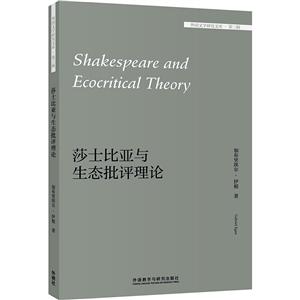预估到手价是按参与促销活动、以最优惠的购买方案计算出的价格(不含优惠券部分),仅供参考,未必等同于实际到手价。
-
>
西班牙语词根宝典
-
>
英语大书虫世界经典名译典藏书系:中国人的精神 (英汉对照)(精选权威版本)
-
>
许渊冲译唐诗三百首:汉文·英语
-
>
四级词汇词根+联想记忆法:乱序版
-
>
The secret garden
-
>
英国文学名篇选注
-
>
许渊冲译千家诗
外国文学研究文库莎士比亚与生态批评理论/外国文学研究文库第3辑 版权信息
- ISBN:9787521320503
- 条形码:9787521320503 ; 978-7-5213-2050-3
- 装帧:一般胶版纸
- 册数:暂无
- 重量:暂无
- 所属分类:>
外国文学研究文库莎士比亚与生态批评理论/外国文学研究文库第3辑 本书特色
适读人群 :学生,教师,一般读者《莎士比亚与生态批评理论》是“外国文学研究文库”系列第三辑的一本。该系列旨在将国外的文学学界的学术成果及时引进和介绍给我国外国文学学者、学生及爱好者,反映外国文学研究领域在世界范围的发展趋势与前沿探索。 “外国文学研究文库”英文书以原版的形式、非英文书以译本的形式出版,并辅之以国内这一领域的资深学者撰写的导读,帮助读者把握作品的脉络,掌握其思想要点,更全面、更深入地理解作品要义。
外国文学研究文库莎士比亚与生态批评理论/外国文学研究文库第3辑 内容简介
自21世纪初,生态批评的逐渐兴起体现了人们在面对生态问题时的深刻反思:我们(人类)错了吗?我们错在哪里?我们什么时候开始错的?我们应该怎么办? 《莎士比亚与生态批评理论/外国文学研究文库·第三辑》将问题的源头定在了启蒙运动,思考了启蒙时代之前,英国文艺复兴的产物——莎士比亚戏剧如何勾勒人与自然、人与其他生物的关系,如何呈现人在地球上及宇宙中的位置,以及如何构建人与人、人与社群的关系。
外国文学研究文库莎士比亚与生态批评理论/外国文学研究文库第3辑 目录
1 The Rise of Ecocriticism
2 Shakespeare and the Meaning of 'Life' in the Twenty-first Century
3 Animals in Shakespearian Ecocriticism
4 Crowds and Social Networks in
Shakespeare
Conclusion
Notes
Bibliography
Index
外国文学研究文库莎士比亚与生态批评理论/外国文学研究文库第3辑 节选
《莎士比亚与生态批评理论/外国文学研究文库·第三辑》: Questions of textual corruption (which the 1609 quarto shows), and sexual corruption (which the play of Pericles is much concerned with), can be interrelated in critical works. Wendy Wall studies the diagrams of lineal descent, called stemmata, that are used by bibliographers to represent the relationships between early texts, and she finds them rather like the lines of familial descent used to represent family trees in the study of genealogy. In both, Wall detects a patriarchal fixation that obscures the complex relationships of text and sex that cut across these lines.26 In fact Wall is wrong to deride bibliographical stemmata on these grounds, since the relationships between early printed editions of plays really can be thought about in genetic terms. The reason for this is that most commonly a reprint of a play (say, Q2) was made by using an exemplar of the previous edition (say, Q1) as the printer's copy text. Wall is wrong to think that such lines of descent are patrilineal and suppress the matrilineal possibilities, for in fact there really is only one ancestor text (not two) for each descendant. That is, printed editions are made by something like mitosis (cloning) of the parent rather than by meiosis (sexual cell division). Meiosis, sexual reproduction, is a rather better metaphor for the reproductive creativity that happens in authors' minds, as described by Richard II in prison. Meiosis is what happens when Gower's creativity, fertilized by his sources-'mine Authors'-including Godfrey of Viterbo (c. 1120 to c. 1196), was, in the minds of Wilkins and Shakespeare, combined with material from Laurence Twine's Pattern of Painful Adventures (1594), which itself took material from the widely circulating collection of stories Gesta Romanorum from the late thirteenth and early fourteenth centuries. In the bibliographical stemmata of Shakespeare editions, a single text stands at the head of the monogenetic line of descent, and, by contrast, medieval works are more properly conceived as polygenetic, because the earliest versions are almost always multiple semi-independent manuscripts. In Shakespeare's time, however, Gower's reputation was that of standing alongside Chaucer at the creative head of the entire tradition of English Literature. As Philip Sidney puts it, '[first] wer Gower, and Chawcer, after whom, encouraged & delighted with their excellent foregoing, others haue folowed to bewtify our mother toong'. Of the two, Chaucer's reputation was arguably a little less secure than Gower's, as Ann Thompson shows, but importantly for our purposes Shakespeare only ever acknowledged as his artistic creditors this pair of literary predecessors. Shakespeare's debt to Gower is marked by his appearance in Pericles, and his debt to Chaucer by the prologue's notably sexualized reference to him as the work's 'noble breeder' in The Two Noble Kinsmen (Prologue, 10). The recurrence of sexual imagery of artistic fertilization in Shakespeare's collaborative work gives credence to Masten's general claim that collaborative writing excited consciously and unconsciously sexualized descriptions, but it would be a mistake to think that the emergent concerns of singular authorship' were simply aligned with heterocentrism. In Shakespeare the contrast is clearly between solitary self-division of the faculties-making the brain female to the soul, in Richard IT's soliloquy-by which artistic conception remains monogenetic, and collaboration as a division of labour that in making the work polygenetic risks reducing the dramatist to a mere conduit for another's words and ideas. The abhorrence of incest at the start of Pericles, and the dramatization of its avoidance at the end, we can read as necessary self-justifications for a new way of working that Shakespeare adopted in his forties in order to appropriate 'the juice', as Gary Taylor calls it, of younger, more successful men. ……
外国文学研究文库莎士比亚与生态批评理论/外国文学研究文库第3辑 作者简介
作者,加布里埃尔·伊根(Gabriel Egan)是英国德蒙福特大学的莎士比亚研究教授和文本研究中心主任,撰有多部有关莎士比亚和生态批评方面的著作。 主编,金莉:北京外国语大学教授、博导,文学博士。研究领域为美国小说与美国女性文学。目前担任北外王佐良外国文学高等研究院院长和《外国文学》杂志主编。主要著作包括《文学女性与女性文学》《20世纪美国女性小说研究》《当代美国女权文学批评家研究》,并发表论文多篇。
- >
有舍有得是人生
有舍有得是人生
¥20.1¥45.0 - >
诗经-先民的歌唱
诗经-先民的歌唱
¥18.7¥39.8 - >
上帝之肋:男人的真实旅程
上帝之肋:男人的真实旅程
¥30.5¥35.0 - >
苦雨斋序跋文-周作人自编集
苦雨斋序跋文-周作人自编集
¥6.9¥16.0 - >
我从未如此眷恋人间
我从未如此眷恋人间
¥17.5¥49.8 - >
大红狗在马戏团-大红狗克里弗-助人
大红狗在马戏团-大红狗克里弗-助人
¥3.6¥10.0 - >
自卑与超越
自卑与超越
¥16.7¥39.8 - >
山海经
山海经
¥22.4¥68.0
-
中国对外传播话语模式研究
¥26.4¥33.9 -
英语世界的《金瓶梅》翻译与研究:::
¥42.8¥58 -
4.23文创礼盒A款--“作家言我精神状态”
¥42.3¥206 -
4.23文创礼盒B款--“作家言我精神状态”
¥42.3¥206 -
一句顶一万句 (印签版)
¥40.4¥68 -
百年书评史散论
¥14.9¥38



















